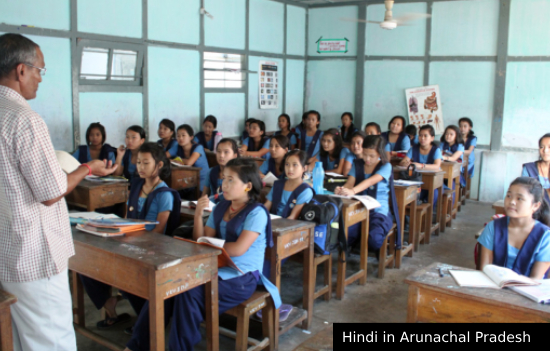Know how Hindi language binds people of the Indian state of Arunachal Pradesh. Other states may choose to follow Arunachal.
At a time when some parts of India are swept
by a storm of protest against Hindi, Arunachal Pradesh in northeast India is a
striking contrast.
Arunchalis don’t just speak Hindi—they have embraced it with their heart and soul. Here, Hindi
is not just a language; it is a bridge
that connects 26 tribes and over 100 sub-tribes, nurturing
a sense of unity and shared identity.
Speak to a local woman in Itanagar, and she responds in impeccable Hindi—leaving one pleasantly surprised. This is the same Arunachal that is often perceived as remote, tribal, and cut off from the mainstream. But here, the sweet strains of Hindi songs fill the air; conversations flow in clear, fluent Hindi. Pick up a phone, and you hear tunes from classic Hindi films. Chat with anyone, and you're met with well-formed Hindi phrases.
While in some Indian states, Hindi is viewed as a threat to cultural identity, in Arunachal, it has found a home in people’s hearts. In Arunachal Hindi has united.
The Chief Minister of Arunachal Pradesh, Mr. Pema Khandu said, “Our diversity is such that if I speak in my tribal language, people of another tribe won’t understand. In such a situation, Hindi is the only language everyone understands.” He added, “From election campaigns to the Assembly, from villages to security forces—everywhere, Hindi is spoken. Even the youngest village children can communicate in Hindi.”
Isn’t that a matter of national pride?
Arunachal is a sensitive border state. Soldiers from across the country - Army, Paramilitary, Border Roads Organisation—are posted here. In this vast linguistic spectrum, Hindi becomes the thread that binds everyone together. Whether it's a soldier or a tribal villager, Hindi is their common linguistic link.
The presence of Hindi has not threatened the existence of any language or dialect spoken by the people of Arunachal Pradesh. Both co-exist.
It’s ironic that while Hindi is the language of every soldier on the border and every villager in the North and East, some political figures brand it as “cultural invasion.” Most forget that Hindi is India’s link language! Hindi binds, not threatens.
In Arunachal, never once during the process of teaching or learning Hindi have we seen anyone oppose it. In the rural hinterlands, even elders greet you with a proud “Jai Hind,” making heart overflow with joy. justify'> justify'>Talk to the youth of Arunachal—they think, speak, and embrace Hindi with pride. Whether it's a festival, school assembly, cultural event, or daily conversation—Hindi has become the lifeblood of daily life here.
Chief Minister Khandu states, Ever since education arrived in Arunachal, Hindi has been part of the curriculum. There’s never been a problem in learning or teaching it.” Hindi class VKV, Jirdin. Maximum students are from Adi tribe.
Hindi class VKV, Jirdin. Maximum students are from Adi tribe.
This is all the more remarkable considering
that adopting a single language in such a multi-lingual region is no small
feat.
However, the Chief Minister equally emphasizes the importance of preserving local languages. By establishing the Department of Indigenous Affairs, he has shown that embracing Hindi doesn’t mean abandoning mother tongues. Rather, it’s a complementary relationship—preserve your dialects, but adopt Hindi as the common language of communication.
In Bharat, each language is a flower—Hindi is the thread of the garland binding them together. Every dialect, every region, every community is invaluable in its own way. But when it comes to dialogue, unity, and connection, we need a language that is simple, popular, and widely accepted—and that language is Hindi.
Hindi is not imposed. It is a language that
the people have adopted willingly,
lovingly, and proudly. Arunachal is living proof. Where there is love
for language, there is no discrimination.
Sceptics might argue that Tamil Nadu or Maharashtra are not like Arunachal – there are other people besides tribes. Correct. It is all a question of attitude. The people of Arunachal could have chosen to speak in their own language/dialects and make communication difficult. But better sense prevailed. They chose a language that binds and not threatens their local language.
Conclusion
In Arunachal Pradesh, Hindi is more than just a language. It is a bridge of dialogue, unity, and cultural harmony. It has brought together diverse tribes, tongues, and traditions. This state is living evidence that the proper use of language can lay the foundation for unity, trust, and development.
People of Maharashtra could instead take pride that it was a Maharashtrian Eknathji
Ranade who felt the need for schools in Arunachal, hence Vivekanand Kendra Vidyalas. They run 42
schools in Arunachal Pradesh today.
Arunachal Pradesh has shown the way to co-existence of languages. Other states may choose to emulate Arunachal.
Author Anand Mohan Mishra is since 1998, a Hindi Teacher working at Vivekananda Kendra Vidyalaya
(VKV), Jairampur,
Changlang District, Arunachal Pradesh. School is about 30 kms from border
with Myanmar. He is a Post Graduate in Economics from Bhagalpur University.
Also see
albums/read
1. Children
of Arunachal Pradesh
2. Tawang
Monastery
3. Swami
Vivekananda Inspired Schools in Northeast India
4. A
comprehensive history of the Dravidian Movement in Tamil Nadu
5. Making a case for Sanskrit as India’s national language
6. History
of Hindi
7. Tamil lady in Mahabalipuram learn Hindi to promote her business